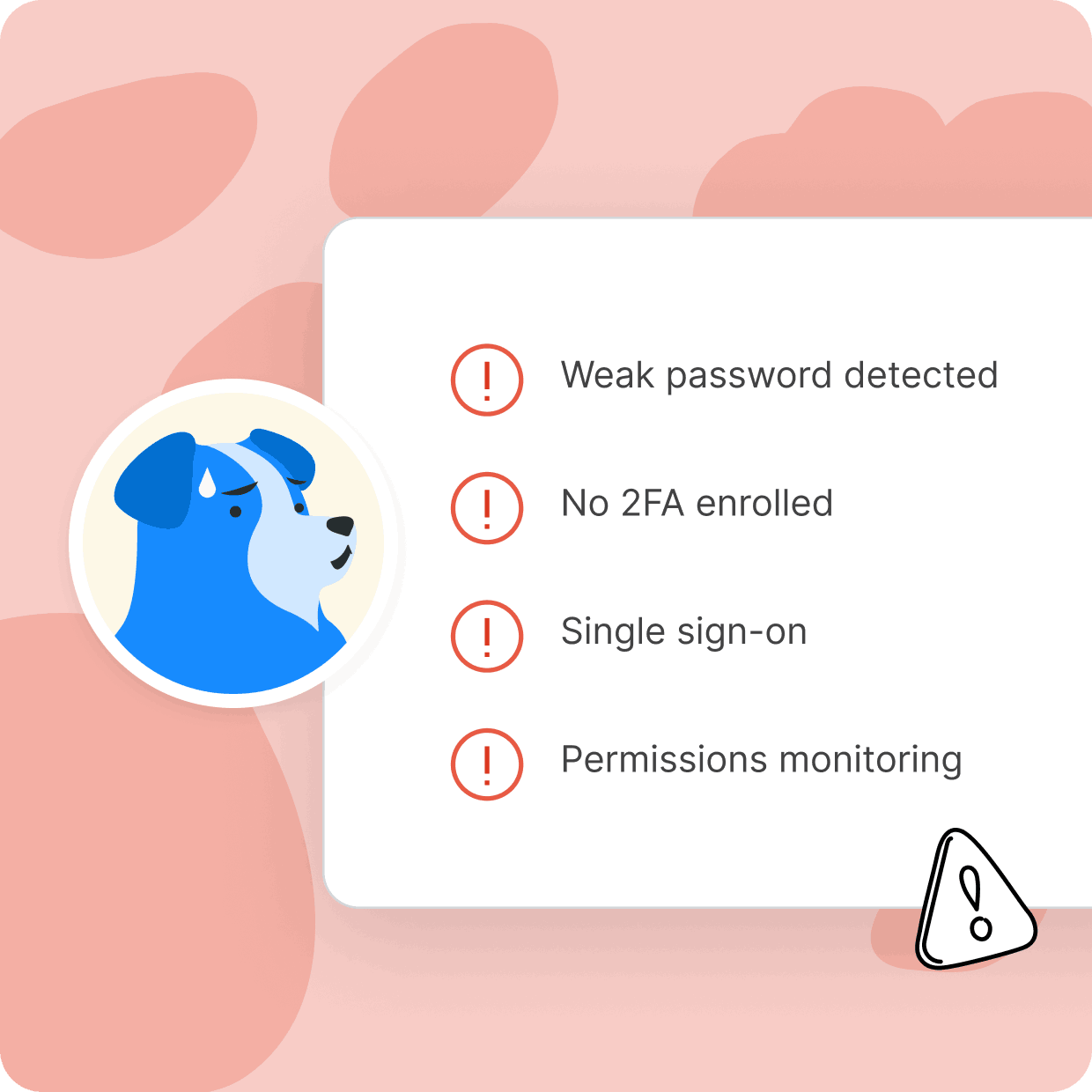Application security risk management is a systematic approach to identifying and mitigating potential security threats in software applications to protect sensitive data and prevent unauthorized access or breaches.
Unfortunately, many applications don't support identity standards like the Security Assertion Markup Language (SAML) and the System for Cross-domain Identity Management (SCIM) specification. Without native support for these standards, applications either can't work with many PAM solutions or require expensive integrations.
Cerby allows you to manage all your SaaS administrator accounts, rotate credentials, and monitor and audit privileged account activities. In this guide, you'll learn about different PAM tools, the challenges, and the players.
Secure Privileged Accounts
Not all accounts are created equal. Some come with administrative permissions that put sensitive data at risk when in the wrong hands. With Cerby, you can help protect your business from bad actors, mistakes, and data breaches.
With Cerby You Can

Secure your SaaS admin accounts

Protect your business from data breaches

Eliminate the costs of custom integrations
Application Security Risk Management
As more businesses and organizations strive to keep up in the era of digital transformation, application security risk management has become ever more important for companies of all sizes across numerous industries. With the rise of cyber threats and data breaches, application risk management has become an essential component for organizations attempting to safeguard their sensitive data and information while also ensuring the uninterrupted operation of internal systems and applications. But what is security risk assessment, exactly?
Application security risk management refers to the undertaking of identifying, assessing, and mitigating potential security risks within a specific application. This approach often involves a comprehensive evaluation of the application’s architecture, code, and general environment to locate any vulnerabilities or weaknesses that could be exploited by cyber attackers. By quickly identifying various vulnerabilities, organizations can be more proactive in developing measures to address the risks before they are exploited, thereby preventing serious security breaches or other incidents.
The Ponemon Institute surveyed, across the U.S., 595 IT and security practitioners that are involved in their organization’s identity and access management strategy. A key takeaway from this research is that organizations don’t know what they don’t know when it comes to nonfederated applications. Also, 52% of respondents mentioned that their organizations experienced a cybersecurity incident caused by the inability to secure these nonfederated applications. There is also a high desire to prioritize nonfederated application security, but the risk is underestimated due to a lack of awareness.
The security risk assessment is perhaps the most important aspect of application security risk management. This is the process by which an organization may identify potential security threats and determine how likely those threats could be exploited by cybercriminals. Throughout this process, organizations can cultivate a better understanding of how to protect their critical assets and implement several appropriate security controls and measures to safeguard business operations and sensitive information.
Cyber attacks have become a major concern for businesses and other organizations as hackers develop increasingly sophisticated methods of exploiting vulnerabilities in applications. Companies that fail to implement effective application security risk management strategies put themselves and their customers at risk of suffering significant financial losses, reputational damage, and potential litigation.
Because of this, application security risk management is a crucial part of the process that ensures the safety of applications and protects organizations from various security threats. By implementing effective application risk management strategies, businesses and organizations can safeguard their vital assets and maintain their customers' and stakeholders' trust and loyalty.
Information Security Risk Assessment
The process of identifying, evaluating, and prioritizing threats to an organization’s sensitive data and information systems is known as information security risk assessment. This process involves a comprehensive analysis of the security risks an organization may be faced with, taking into consideration important factors like the nature of the data being protected, the systems and applications involved, and the potential impact of a security breach or cyberattack.
The application of risk assessment to application security means an organization must identify and analyze all of the potential security risks for a particular application. This process can include the identification of potential vulnerabilities, the assessment of the probability and magnitude of a security breach, as well as the implementation of appropriate security controls to mitigate these risks.
A common tool companies often use in application risk assessment is an application risk assessment questionnaire, which provides a more structured approach to identifying and understanding the security risks of an application. These questionnaires usually cover a broad range of topics, including the application’s architecture, data flows, access controls, and third-party integration capabilities.
In terms of threats, some common application risk examples may include SQL injection attacks, cross-site scripting (XSS) attacks, and unauthorized access to sensitive data. When companies conduct regular risk assessments and implement the appropriate security controls, organizations can significantly reduce the likelihood and impact of various security threats. This, in effect, safeguard’s the organization’s sensitive data and allows the business to maintain its reputation and the trust of customers and stakeholders.
Risk Management Program
A risk management program refers to a comprehensive approach to identifying, assessing, and mitigating risks facing an organization. It involves a structured, systemic process for managing risks, ensuring that all the appropriate controls are in place to reduce the likelihood of successful cyberattacks and limit the amount of damage that can be done if bad actors can access sensitive information and/or systems.
One of the primary facets of a risk management program is the risk management procedure. This procedure provides a basic guideline of the steps that the organization must take to identify, assess, and respond to risks, including the roles and responsibilities of key stakeholders as well as the timeline for each step of the process.
Another important component is the risk management database. This provides a centralized location for storing and accessing information about potential risks, including the probability and impact of each risk, the security measures in place to respond to those risks, and any ongoing monitoring or management activities.
An application risk assessment framework is another vital aspect of a risk management program. This can provide a standardized approach to identifying, assessing, and responding to potential risks that threaten a particular application. The framework usually includes a set of guidelines and procedures for conducting application risk assessments, identifying weaknesses and potential threats, and implementing the appropriate controls and security measures to circumvent these risks.
Security Risk Assessment Example
The first step involved in conducting an application security risk assessment is to identify the most critical assets and any potential threats facing the application. This may involve analyzing the application’s architecture, data flows, access controls, and third-party integrations. Once all the threats have been identified, the next step involves assessing the likelihood and impact of each threat. This can involve an in-depth analysis of the probability of each threat occurring and gauging the potential impact on the application and the organization.
To help facilitate the process, organizations can choose to implement an application assessment checklist or an application risk assessment template. For instance, a security risk assessment example might include a detailed analysis of potential threats and information about their impact and response procedures.
Utilizing an application risk assessment checklist can help businesses identify potential security risks and vulnerabilities within applications and take appropriate measures to circumvent or mitigate these risks. Businesses that are proactive in these efforts can drastically improve the security of their applications and maintain the trust of their customers and stakeholders.
NIST Cybersecurity Checklist
Utilizing established security frameworks and guidelines like NIST and OWASP is essential for businesses to adequately manage various application security risks. With a NIST application security framework, organizations can readily identify and address potential security risks. The frameworks also provide basic guidelines and best practices for implementing effective security measures.
The NIST cybersecurity checklist provides a comprehensive set of guidelines for businesses to follow to keep information and systems safe and secure. The checklist goes into detail about a variety of things, including access controls, network security, and incident response protocols, and provides specific instructions that organizations can utilize to improve their overall security posture.
Similarly, the OWASP testing guide v5 checklist XLS and the OWASP checklist XLS provide a framework to help businesses identify and address certain security vulnerabilities within applications. These checklists provide organizations with a wealth of information about authentication, input validation, and data protection, and they also provide actionable responses for organizations to improve the security of their applications.
By relying on established security frameworks and guidelines, businesses and organizations can make sure they are taking a comprehensive approach to managing their application security risks. These frameworks and guidelines are based on industry best practices and are also regularly updated to keep up with the latest cyber threats and other digital vulnerabilities.
Application Security Assessment Checklist
There are numerous tools and solutions available to help organizations manage application security risks. One such solution is Cerby, an access management platform for nonfederated applications. Cerby offers a platform specially designed to help businesses manage access to their applications that don’t support standards like single sign-on and security APIs.
Another tool that can be incredibly useful for application security risk management is an IT risk assessment checklist PDF. This type of document provides a detailed set of questions and prompts that can help businesses evaluate their overall IT security posture, including various application security risks. This checklist can be leveraged to identify potential weaknesses and risks, prioritize the most important areas for improvement, and develop comprehensive strategies for managing these risks moving forward.
Utilizing tools and solutions like an MSP risk management platform, businesses, and organizations can manage and mitigate application security risks systematically and comprehensively. By proactively identifying and addressing potential security risks, businesses can minimize their vulnerability to cyber-attacks and other security breaches, protect their data and critical systems, and maintain the trust of customers and other stakeholders. And in an increasingly digitized world, bolstering cybersecurity initiatives is an important investment for businesses and organizations of all sizes across every industry.
